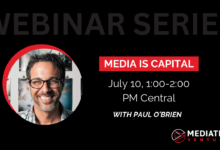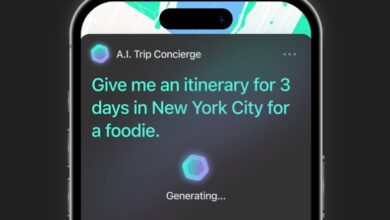
I had the honor of sharing some thoughts with the Small Business Festival about the Future of Media, with the context being the impact of media innovation on small business owners and entrepreneurs. Of course, that includes everyone from a local realtor to the musician building their business – the topic was sparked by the fact that the pace of technology in media, be that online, in mobile, through video, or content creation, races so quickly today that it’s nearly impossible to run a business while keeping up with how to start simply, with the resources and channels that media offers.
[video_embed name=”SBF Keynote”]I’m enthusiastic about one narrative about the future of media in particular. Given the fact that there is an [irrational?] exuberance for virtual reality, picture how VR has potential for your business.
The hottest innovation of the year (by many measures and opinions), it would seem that you must do something with VR: new media that is getting so much attention that it must be the panacea for all of our challenges! Certainly, you’re paying attention to it, aren’t you?!
Shouldn’t you be? Should you be?
Frankly, it’s a technology that still feels a bit like the 3D television enthusiasm of a decade ago.
Virtual Reality, these headsets, I began in my talk, actually show us a way to THINK about what’s going on in media: distractions. As a business owner or entrepreneur, media provides distractions and it’s in those distractions that we lose sight – we lose our vision: exemplified in wearing VR goggles.
We’re all distracted by things like Instagram, Snapchat, or Facebook, so much so that you lose perspective on what it is that you really need to focus on as a small business.
 Digital media (online media: marketing and advertising) is not as complicated as we all make it seem. As a small business person, you don’t need to know how to do SEO, how to advertise on AdWords, how to be on Facebook, or how to build your own website, but we get distracted by these opportunities because we do need to be there. How do we simplify what we’re doing online so that we can appreciate, in what we’re doing as businesses, that our customers are no longer on “Television,” “Print,” and “Radio,” as the traditional sense. Everyone is now on the right hand of this chart reflecting the migration of media consumption to “Digital.” But what is “Digital” really??
Digital media (online media: marketing and advertising) is not as complicated as we all make it seem. As a small business person, you don’t need to know how to do SEO, how to advertise on AdWords, how to be on Facebook, or how to build your own website, but we get distracted by these opportunities because we do need to be there. How do we simplify what we’re doing online so that we can appreciate, in what we’re doing as businesses, that our customers are no longer on “Television,” “Print,” and “Radio,” as the traditional sense. Everyone is now on the right hand of this chart reflecting the migration of media consumption to “Digital.” But what is “Digital” really??
Interestingly, many (largely in places like Silicon Valley) have now been working in “digital” for decades. I started my career with Yahoo nearly 20 years ago and imagine the perception that people therein had then – digital isn’t (wasn’t) the future, this is now. Everything in 2002 was already digital: audio consumption, video, and advertising: there is already a generation of people who don’t really know anything traditional, as “digital” is the default. But that still doesn’t define what “Digital” means nor why pundits and studies are distinguishing it from Radio and Print – at least not really… do you know what to do with “Digital” in the same way that you know how to buy a newspaper ad? No, of course not; Digital doesn’t mean anything making the very idea that media and advertising today is “Digital,” a complication for you. A distraction, like VR, no? Digital is not the default for most people, for most business owners, and it’s only today becoming so for millions more as we adopt mobile, streaming, social media. How might we help small businesses grasp HOW to leverage digital media given that they must but don’t naturally do so?
 That distinction, that challenge, is drastic in looking at the consumption of television, newspaper and magazine, radio, and digital channels by age. Small businesses are challenged with continuing to serve the majority of people who still largely consume traditional media, while shifting to our next generations which all but only consume digital. And we’re still distracted by what it means to actually be present in digital given so many ways in which to do so.
That distinction, that challenge, is drastic in looking at the consumption of television, newspaper and magazine, radio, and digital channels by age. Small businesses are challenged with continuing to serve the majority of people who still largely consume traditional media, while shifting to our next generations which all but only consume digital. And we’re still distracted by what it means to actually be present in digital given so many ways in which to do so.
Media Consumption Habits are Generational
What first struck me as a way to simplify HOW to think about media innovation and these transitions is that it’s entirely generational.
Don’t try to think in terms of doing everything, being everywhere, and knowing all of the possibilities – merely think in terms of age groups.
We’re profiling and segmenting you and your customers.
I’m in my forties and so my experience with media is almost entirely driven by my experiences with the laptop era. I have my laptop everywhere. Sure, I use a smartphone and I love my smartphone but everything I do is based on my career starting and ending on a mobile computer.
People before that? They had the PC – the desktop – and a land line phone. Before that? Print and television.
Thus we can start to grasp simply the future of media as people in their twenties are almost entirely attuned to the smartphone experience. People my age and older are ADOPTING smartphone behaviors but just as I was bred with a computer on my lap, younger generations are bred with a computer in their pocket.
As a small business, as any business, if you are not on that device, that mobile computer in pockets, you might as well not exist. In the same sense that 10 years ago, if you didn’t have a website, you didn’t exist for someone like me, everyone younger than me today finds everything they do through their smartphone.
But How Do We Reach Them? Online Advertising Works
Don’t overthink it. If online advertising is NOT working for you, you are doing something wrong. Evidence that it works needs no more discussion nor proof than the fact that the majority of all advertising dollars today are on Google and Facebook. It works.
Digital media and online advertising works for EVERYONE because it can be done so as to guarantee a positive return. That’s something that was never before possible.
We’re not in this article going to explain how to do that with such a guarantee, that’s an entirely different discussion; what I want you to do is simply change the way you think to grasp that promoting your business online can be done in a way that guarantees positive results.
If you’re working with a consultant, an agency, or someone on your team who is making it seem complicated or who can’t explain or fix why something might not be working, they aren’t doing their job! Yes, all of this is complicated and no, I’m not advising that you know how to do it but as you head into this future of media, know that it absolutely can work for your business – so if it’s not, something is wrong.
What MIGHT Not Be Working for Small Businesses Online?
In this digital medium, user behavior has changed. Your customers do NOT act as they do offline. To make sure digital media works for you, you have to appreciate that their behaviors are different and address any aspect of that behavior that might cause a point of failure for your business.
That sounds complicated. What I mean is that where once someone would see your ad in a newspaper and then either a) call you or b) walk in your store, today that isn’t the case. People never just do that. If there is any point in THEIR behavior where your business fails to address their expectations, you lose business.
Making digital work is as simple (yet complicated) as making sure you are THERE where your customer expects you to be.
In media today, thanks to the internet and digital experience, search and scroll are the dominant ways content is consumed.
Read, watch, and listen are the formats.
Change the way we think about how people engage with media. People engaged with the newspaper or television in certain ways. When we watched a commercial on television we were sitting back, engaged without distraction. That way of consuming media is gone.
We search and we scroll.
That’s HOW people consume what’s digital. That’s how they consume video, audience, written and written content because of digital: because of the internet and smartphone. Behavior has changed and what small business owners can appreciate is though the technology and formats have changed and become complicated, what really matters is only that the audience’s behavior is different. At the end of the day, everyone still reads, watches, and listens.
Driving on the road listening to the radio or seeing a billboard… they can’t search or scroll. But because our lives are now attuned to digital experiences (the internet and smartphone), that’s what people expect to be able to do.
If your messages, promotions, and advertising aren’t designed with that behavior in mind, YOU DON’T EXIST. Plan for people to do that and then address the experiences where people expect people to engage with you effectively.
People Block Ads
Have you heard of AdBlock? A technology that removes ads from websites, ad blocking is becoming so pervasive that News Media sites are freaking out, telling readers that they can’t see the content they produce without their AdBlocker turned off as Ads are the only way they can make money.
Now, you might sit with me here and think… “Well that’s a fair point. People producing content, journalists in this case, need to get paid and so why should people be allowed to block those ads??”
And yes, it is a fair point. But more importantly, we might look to WHY that’s being done.
In 2010, 21 million people had apps and plugins in their browsers that blocked ads. In 2015, just 5 years later, 198 MILLION people were using AdBlockers.
What is that telling us? People do NOT want to see your traditional billboard ad anymore; certainly not in an experience online where they are going to Search and Scroll.
People are done with misinformation
Advertisements, one could surmise, are distractions because people know that they no longer need to take them at their word. We can search and scroll to find other information about a business.
In my talk, if you’re following along, let’s consider politics for a moment. A decade ago, Barack Obama and campaign noted the future of media and recognized that at that point in the evolution of our behavior and technology, people were voraciously consuming social media. Was your business there?
More recently, what was the media trend that politicians leveraged to sway votes? The more recent trend was in memes, citizen journalism, and filtering of social media… enabling Donald Trump to attack traditional News Media because our behavior became accustomed to only seeing, reading, hearing what we want on demand while News Media was scrambling to figure out how to make money by creating content that was popular. Fake News.
None of that is a commentary on politics, it’s a way to appreciate how they were adjusting to macro-media trends to persuade their audiences. Is that not what you too need to do?
To wit, I have someone who comes to my door every few weeks and knocks to tell me my trees need to be trimmed and that they are available to do so. Politicians used to go door to door too, didn’t they? Perhaps you, in your business, still put flyers on cars or hire Sales people to make cold calls.
People no longer want to be sold, they want to know. Consumers crave authenticity. Consumers crave control. Consumers crave validation.
Every time that person knocks on my door I look at my trees and think, “yep, they do need some work… I’ll go online and search for someone to provide the service I want. Thanks for the reminder guy at my door whom I’ll never hire.”
That may sound harsh but I want to impress upon you to appreciate that people don’t want to be sold to! I will NOT make a decision on a business, service, or product because an ad, a Sales call, or a person at my door tells me I should. I’m going to search and scroll for the solution that meets my needs… and if you aren’t there, you aren’t getting my business.
There is a distinct trend in society that few have talked about…
- In the 1990s and 2000s we essentially invented privacy (hot topic today) because for the first time we could be in public, online, and anonymous. We could build websites and social profiles that didn’t have to correlate with the actual person behind them. People, for the first time, could speak their mind and be themselves because no one was the wiser about who they were.
- In the 2000s and through today though, we’ve been reacting to that having been fed stories, online ads, and websites in which we can’t hold anyone accountable. We no longer trust reviews, ratings, articles, and ads we see about businesses because we KNOW that they could be completely manufactured.
People are demanding a personal relationship with you as a business owner or entrepreneur BECAUSE we know that any other source of information about you might be misleading. I want to consider you on MY terms, I want to connect with you on my terms, I want to validate that you will provide to me what I seek; rather than my being willing to engage with your business because an ad/sales person/article says I should.
Where Small Businesses Should Start with Media
Heretofore, I’ve shared a lot of what doesn’t work and painted a picture that, while media today can “guarantee” a positive return, it’s still really complicated. So what are the fundamentals that every business must appreciate today??
Here’s where you need to invest your time, your budget, and your attention:
- Effective website
- Audience and engagement on social media
- Discoverability on mobile
- Conversation with YOU
Stop worrying about SEO, Content Marketing, Adwords, putting campaigns on Facebook, being listed on Maps, chat bots, and email marketing. Just for now – stop stressing about such things as those are the tactics and channels available to you. Take a step back and just think about those four things:
- Does our website work well for every conceivable experience? Can someone see it on a mobile device? What if someone wants to chat? What if someone else wants to fill out a form? Maybe I’m just looking for a map. MOST media channels and marketing campaigns FAIL not because the campaigns fail but because you have a point of failure when people reach your site.
- Are you connecting with your audience – not just your customers! – everyone related to what you do, everywhere they might be? Now, before you go saying to me that your customer isn’t on LinkedIn or Twitter, let me tell you from 20 years of work on the internet that you’re wrong. Your potential partners, employees, customers, influencers, journalists and reporters, affiliates, and more are in social media channels! If you’re not, there is no other way to think about it than:
you’re not; not that they aren’t. - Everyone uses a smartphone to do everything. I’m looking up your address, mapping my route,
placing my call, considering friends opinions, following you on twitter, taking a picture, looking at yours on Instagram. If you’re not everywhere I am on the phone, you’re not being considered. - Finally, authenticity starts with you. You personally – not your field rep, sales person, chat bot, nor customer service team. Because I can SEARCH and because the internet makes it possible, I don’t care if you are the Owner, Sole Proprietor, Artist, Founder, or CEO – I expect to be able to find and reach you. Can I?
Those are the fundamentals of today’s economy and the experience your customers and audience expects to have with you.
This isn’t just the future of media, this is the present of media. If you’re not there, you might as well not be in business. This is a revolutionary shift in how you do business but I want you to find success and that can only happen when all evolve to serve the fact that our audience ALWAYS now does business this way.
What businesses can do with media is message
Salesforce published a study last year that showed that in mobile, the overwhelming use case is still message related.
Where the internet changed our behaviors to know that we can search and scroll for other options, mobile is reinforcing that one-to-one communication we can have with businesses is in fact what we expect to have, since we’re using our smartphones for, primarily, just messaging with one another.
Every day, 91% of us are on email via our phone, 90% of us are text messaging, 75% of us are on social media (messaging), and 62% of us are consuming news (messages from the media). Mobile devices don’t require that you have an app but they are a means to MESSAGE with your audience.
The technologies exist that your small business can use to message people (search and scroll for them). You can push messages to phones. You can message from your laptop in your office to a chatbot on Facebook. You can do this and you must.
Just for fun…
Think about ride sharing and taxis businesses in this context. Austin is an amusing place for me to live because last year our city made it onerous for ridesharing apps while making an argument that their reasoning was that they wanted to make sure taxi drivers remained gainfully employed.
But think about what we’ve been talking about here. My expectation is that I can search, scroll, and use my smartphone to message and get to know the businesses with which I engage.
Now, imagine you were starting a taxi business today and that you want to get some funding to run that business. Imagine you were planning to operate your taxi just as you might be actually operating your small business today… you put up some ads, a phone number, a sign on your car/office, and you hope the business will just start coming in.
And then you scratch your head and wonder why you’re struggling.
No one expects to stand on the side of the road anymore and raise their hand to get a car with an anonymous driver to pull over and pick them up. No one will just walk into your business because you told them so.
You can’t run your small business like an old taxi company just because that’s how it has been done. Today, I can search and scroll, and pay, for the driver I want; prompting a business to come to me on my terms.
There’s a bit more in the video so I hope you’ll give that a listen and enjoy. Spark a thought, throw a comment or question, and let’s keep the future of media going.







Good point, but we have to consider the entire ecosystem of audience engagement. A lot of times the success of the “scrollable/searchable” media is dependent on those static nudges to lead them to the media pieces that give them the ability to dive deeper into their personal experience with the brand.
Interesting perspective in your piece!